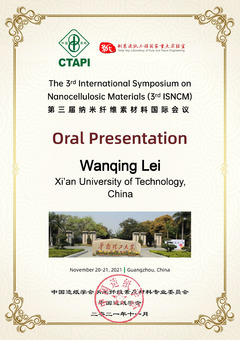PREPARATION OF CELLULOSE NANOCRYSTAL FROM OFFICE WASTE PAPER AND ITS POTENTIAL APPLICATION IN THERMAL REINFORCEMENT OF POLYURETHANE
ID:11
Submission ID:28 View Protection:PRIVATE
Updated Time:2021-11-01 10:17:19
Hits:973
Oral Presentation
Abstract
Annually a tremendous amount of office waste paper is discarded creating environmental pollution. Therefore, how to make this paper from waste to wealth and use it in new approaches have become a meaningful and challenging work. In this work, office waste paper being a cellulose rich biomass was employed for the production of cellulose nanocrystal by acid hydrolysis with different acid concentrations but without subjecting office waste paper to alkali and bleaching treatments. The results showed that acid concentrations had great influence on morphology and property of cellulose nanocrystal. Cellulose nanocrystal prepared using acid concentration of 65% coated on polyethylene terephthalate sheet not only had a better water vapor barrier property but also was on a par with the transparency of polyethylene terephthalate, which was hopeful to be used as coating materials in packaging materials. Cellulose nanocrystal prepared using sulfuric acid concentration of 59% had the highest crystallinity and this concentration was the transition concentration for the production of opaque cellulose nanocrystal film with convoluted nanofibers to transparent one with orientated nanofibers, which had the potential to be used as nano fillers. Moreover, cellulose nanocrystal prepared using sulfuric acid concentration of 59% was used as organic filler to reinforce polyurethane. Polyurethane is the widely used polymer and has numerous particular performances, such as high resilience, good mechanical property, excellent weather and abrasion resistance, and good flexibility at low temperature, etc. However, for some specific uses, some thermal properties of polyurethane, e.g., thermal stability, are not adequately high, which limits its application in many fields. Hence, a series of cellulose nanocrystal/polyurethane nanocomposites with varying content was prepared by two incorporation routes including blending method by sonication after polyurethane synthesis (BCNC/PU) and the alternative in-situ during the polyurethane synthesis process (CNC/PU) to modify thermal property of polyurethane. The results showed that cellulose nanocrystal widened the particle size distribution of polyurethane and made the dimension of emulsion particles increase. Importantly, cellulose nanocrystal was covalently bonded to polyurethane, and specifically concerned with the hard segments of polyurethane resulting from the strong hydrogen bonding. The interactions between cellulose nanocrystal and polyurethane caused the increased thermal and thermo-mechanical properties, and decreased water absorption of nanocomposites. However, the interaction in BCNC/PU was not as stronger as that in CNC/PU. The addition of cellulose nanocrystal caused a delay around 50 °C in the start of the degradation process, and a delay of 5–18 °C and 2–20°C in the temperatures at 10 and 50 wt% weight loss, respectively. Hence, this work not only provided a new recycling method of waste paper but also provided a thermostable polyurethane with lower cost.
Keywords
Cellulose nanocrystal; office waste paper; polyurethane; nanocomposite; thermal reinforcement
Submission Author
Wanqing Lei
Xi’an University of Technology
Hui Pei
Xi’an University of Technology
Chanqing Fang
Xi’an University of Technology



Comment submit